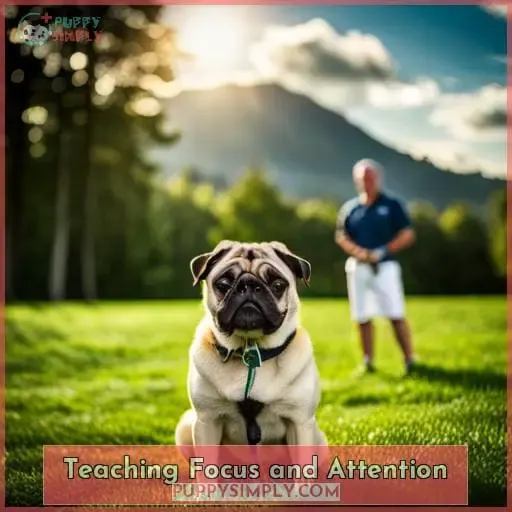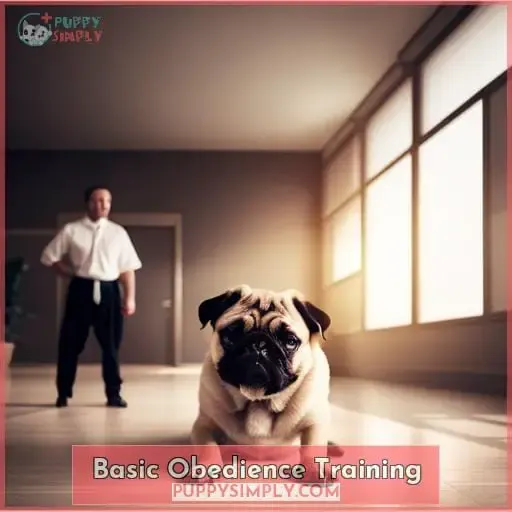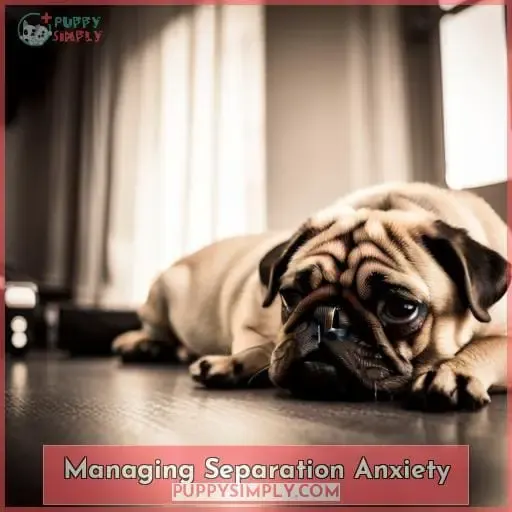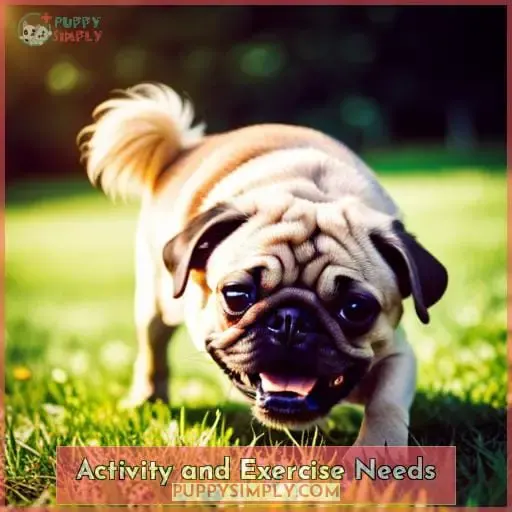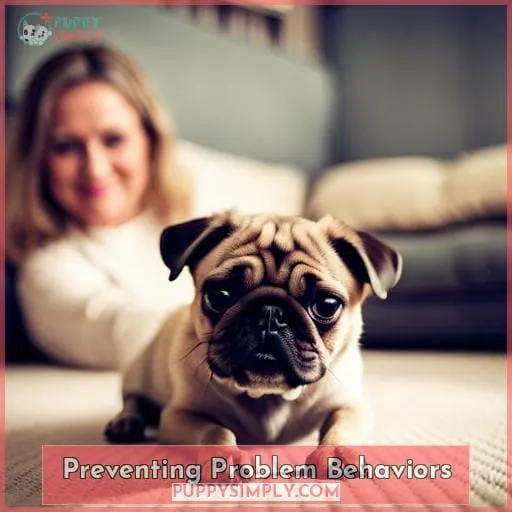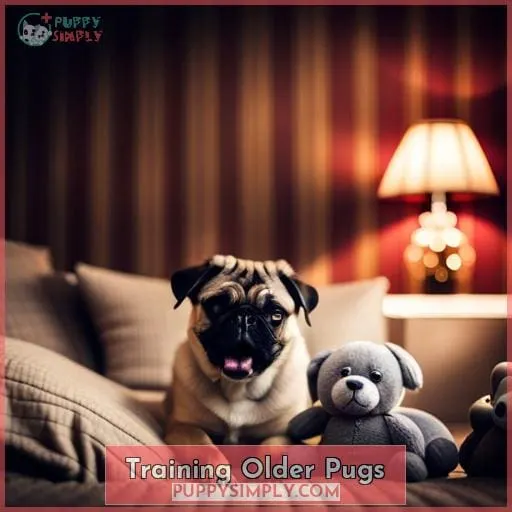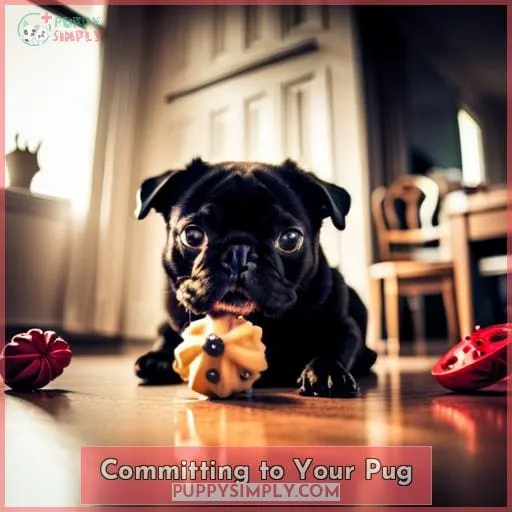This site is supported by our readers. We may earn a commission, at no cost to you, if you purchase through links.
 As a loyal companion bred to charm, your Pug aims to please but needs guidance on good behavior.
As a loyal companion bred to charm, your Pug aims to please but needs guidance on good behavior.
Forget intense training—a little planning and consistency goes far.
Prepare your Pug for success by easing their transition into your home.
With some crate training, managing separation anxiety, providing activity and exercise, and preventing problems, you can train your Pug for obedience and housebreaking.
Stay positive, set boundaries, and commit to meeting their needs.
Table Of Contents
- Key Takeaways
- Establishing Leadership
- Teaching Focus and Attention
- Basic Obedience Training
- Housebreaking a Pug
- Crate Training for Pugs
- Managing Separation Anxiety
- Activity and Exercise Needs
- Preventing Problem Behaviors
- Training Older Pugs
- Committing to Your Pug
- Frequently Asked Questions (FAQs)
- How long do training sessions need to be for an adult pug?
- What tricks and skills can I teach my pug beyond basic obedience?
- What should I do if my pug is fearful or anxious during training?
- How can I train my pug if I have mobility issues or disabilities?
- Are there any special considerations for training an overweight or obese pug?
- Conclusion
Key Takeaways
- Establish leadership with consistency, routine, patience, and affection to build trust and respect.
- Direct focus and attention through interactive games, clicker training, managing distractions, and celebrating progress.
- Practice basic obedience commands like sit, stay, and heel using positive reinforcement.
- Prevent problem behaviors by setting boundaries, providing activity, redirecting behaviors, and rewarding good habits.
Establishing Leadership
Before you can begin training your pug, establish yourself as the pack leader. Be firm, fair, and consistent with discipline and affection.
Alpha training is crucial to establishing leadership. By providing positive leadership, you create a sense of trust and respect from your pug. Family participation is essential in reinforcing this hierarchy within the household.
Consistency is key when it comes to setting expectations for your pug’s behavior. Maintain a consistent schedule for feeding times, bathroom breaks, playtime, and training sessions to establish routine and reinforce your role as the leader.
Additionally, crate confidence can be built through crate training. This provides a safe space for your pug while also teaching them boundaries.
By implementing these strategies consistently with patience and love, you’ll effectively establish yourself as the pack leader. This will allow you to successfully train obedience behaviors in your beloved pup.
Teaching Focus and Attention
Coming from a working breed, Pugs have high energy and drive, which makes teaching focus essential.
Start focus training through interactive games like fetch or tug-of-war to direct your Pug’s attention to you.
Manage distractions during training until your Pug can focus despite stimuli by training outdoors or using enrichment toys.
A focused Pug will progress through obedience and housebreaking rapidly by attending to your cues.
Stay patient and creative while building your Pug’s attention skills.
Basic Obedience Training
You’ll need to teach your Pug some basic obedience commands like sit, stay, come, and heel using positive reinforcement training methods that rely on treats, praise, and patience.
Clicker training paired with rewards like tiny treats make positive reinforcement effective for teaching commands.
Practice short 5-10 minute sessions several times a day to maintain engagement and progress.
Work on leash manners early on by rewarding loose leash walking and giving clear directional commands.
Socialize your Pug puppy to new people, animals, and environments so they become accustomed to sights and sounds.
Pugs can be stubborn, so you’ll need to be consistent yet flexible during training as each dog learns differently.
Celebrate small wins and know that obedience training takes time and commitment.
Housebreaking a Pug
Your Pug’s small bladder and lack of bowel control require commitment on your part to establish a successful housebreaking routine.
- Struggle with litter boxes or going outdoors.
- Paper training provides interim relief.
Set alarms to take them out consistently.
Reward immediately after potty success.
Never punish accidents.
Establishing a consistent schedule tailored to your Pug’s needs, providing positive reinforcement for appropriate potty habits, and committing to interim solutions like paper training can set your Pug up for housebreaking success.
Stay patient, consistent, and positive – your Pug wants to please you. Celebrate the small wins along the journey to reinforce good habits.
Crate Training for Pugs
After housebreaking your Pug, you’d do well to utilize crate training for helping manage their elimination schedule and preventing accidents when unsupervised.
The crate provides a den-like space that makes your Pug feel secure and comfortable when left alone.
Ensure the crate has soft bedding, toys, treats, and ample room for your Pug to move around and lie down.
Place the crate in a quiet area that affords your Pug some privacy.
Reward your Pug for calmly entering the crate and resting inside with praise or treats.
Use the crate when you can’t supervise your Pug to aid housebreaking training and prevent inappropriate eliminations or destructive behaviors.
The crate becomes a safe haven that your Pug associates with rewards and peaceful alone time.
With patience and positive reinforcement, the crate facilitates housebreaking success.
Managing Separation Anxiety
When working with your pug’s separation anxiety, start by training them to become comfortable spending time alone in a safe space in your home.
Use treats, praise, and positive association.
- Create a designated area with a crate lined with blankets, toys, water, and potty pads.
- Use treats and praise to reward your pug for calmly spending time in this area.
- Build up the duration your pug spends alone in this space through positive associations.
Socializing techniques like inviting friends over or taking them on walks can also help reduce separation anxiety by building their confidence.
Committing to consistent training with positive reinforcement is key to managing this common challenge.
Activity and Exercise Needs
Through providing adequate activity, you’ll prevent boredom and problem behaviors in your Pug.
Pugs need daily exercise and mental stimulation.
Engage your Pug in:
- Interactive games
- Outdoor adventures
- Indoor exercises
- Mental stimulation
- Playful challenges
Here are some great activities for Pugs:
| Activity | Description |
|---|---|
| Fetch | Retrieves toys, promotes bonding |
| Walks | Explore outdoors, meets/greets |
| Trick Training | Mental stimulation, earns treats |
| Hide N Seek | Fun game to find hidden toys or treats |
| Tug of War | Interactive play using rope toys |
Keeping your Pug active prevents boredom.
Meet their instinctual needs through play, training, adventure.
An engaged, stimulated Pug behaves better.
Monitor your Pug’s activity to ensure good health.
Vary activities to prevent joint injuries.
Make every day exciting for your delightful Pug!
Preventing Problem Behaviors
Despite meeting their activity needs, you’ll want to curb problem behaviors in your pug by setting clear expectations.
Pugs can develop behavioral challenges like excessive barking, digging, chewing, and separation anxiety without proper training techniques focused on positive reinforcement.
Set a consistent daily routine and meet their enrichment needs with puzzle toys and quality time together.
Respond to unwanted behaviors calmly by redirecting their focus to appropriate outlets, not with punishment.
Reward them often for good behavior.
By being consistent with your pug puppy training using positive methods tailored to their health and emotional needs, you can teach them good habits and tricks to prevent separation anxiety.
Establishing simple commands and rules from the start will make for an obedient, well-adjusted pug.
Training Older Pugs
As your Pug matures into their senior years, you may face new training challenges.
Their senses start to dull, making it more difficult for them to respond to cues.
However, with compassion and positive reinforcement, you can modify their behavior.
Establish a predictable routine catered to their needs. Use treats, praise, gentle touches, and their favorite toys to motivate participation.
Be patient when accidents happen.
Seek advice from your veterinarian regarding suitable exercises or activities for an aging Pug.
Adjusting your approach lets senior Pugs live out their golden years feeling safe, loved, and part of the family.
Committing to Your Pug
You’ll need to commit fully to your Pug’s training regardless of the challenges if you want your pet to be a well-behaved member of your family.
Establish yourself as a consistent leader through positive reinforcement.
Motivate your Pug during training sessions with praise and rewards.
Commit to a regular schedule for activities like walks, play time, and training.
Be patient and persistent when facing training challenges.
Build trust by creating a safe environment where your Pug feels loved.
Frequently Asked Questions (FAQs)
How long do training sessions need to be for an adult pug?
For an adult pug, training sessions should be 5-10 minutes, 1-2 times daily initially.
Work up to 15-20 minute sessions as your pug masters skills.
Short, frequent sessions keep their interest and help reinforce new concepts.
Always end on a positive note so your pug looks forward to the next session.
What tricks and skills can I teach my pug beyond basic obedience?
Teach your Pug tricks:
- Shake
- Roll over
- Play dead
- Spin
You can also train them in canine sports:
- Agility
- Flyball
- Barn hunt
- Obedience trials
Continuing training strengthens your bond.
What should I do if my pug is fearful or anxious during training?
If your pug is fearful or anxious during training, be patient and go slow.
Use lots of treats, praise, and encouragement to build their confidence.
Keep sessions short, fun, and positive.
End on a good note so they associate training with something they enjoy.
Never scold or punish fear responses.
How can I train my pug if I have mobility issues or disabilities?
Try clicker training, which requires minimal movement.
Also, use targeting sticks and luring techniques.
Keep sessions short and engaging.
Praise and reward generously for success.
Are there any special considerations for training an overweight or obese pug?
Losing weight can be challenging for pugs due to their food motivation.
Approach training in short sessions with their favorite treats to keep them engaged.
Avoid scolding; stay positive and persistent.
Their weight makes moving difficult, so use gentle guidance.
Celebrate every success to build confidence.
Conclusion
When the going gets tough, don’t throw in the towel; with time and dedication, you can lead your pug to obedience and housebreaking success.
Though they aim to please, pugs need guidance through training, separation anxiety management, activity planning, and problem prevention.
By establishing leadership, meeting their needs, setting boundaries, and staying positive, you can ease their transition into your home.
Commit fully, and your loyal companion will charm you for years to come.


